Effective Strategies for Removing Wasp Nests Safely
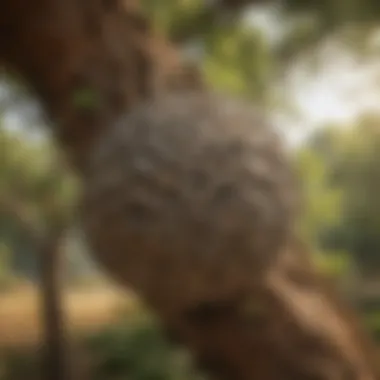
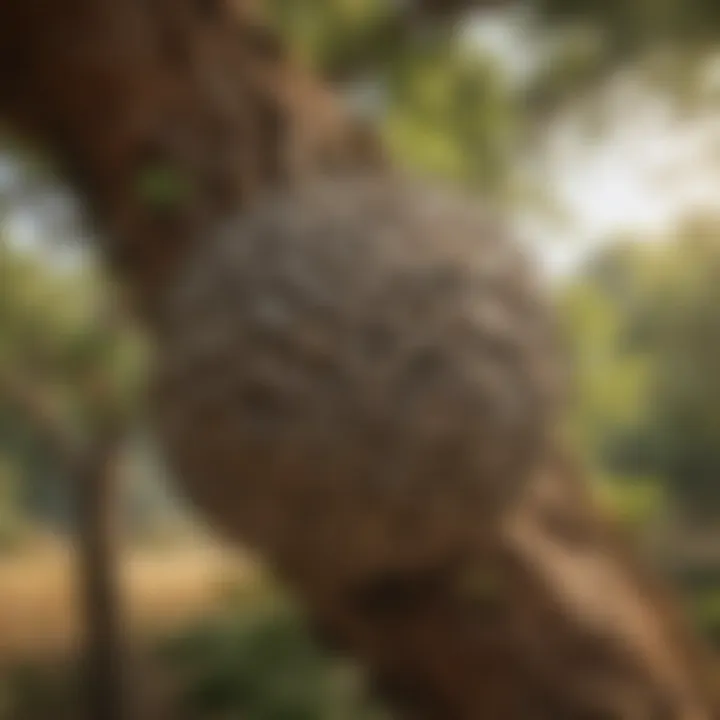
Intro
Removing a wasp nest from your house can be a daunting task. Wasps are known for their aggressive nature, especially when their nest is threatened. Yet, understanding the importance of identifying these pests and knowing how to safely remove them can empower homeowners. This article will explore effective strategies for pest management, providing essential insights into the safe removal of wasp nests while considering the ecological impact of such actions.
Understanding Pests
Definition of Pests
Pests are organisms that interfere with human activities or cause harm to health, property, or the environment. They include a variety of insects, rodents, and other animals. Wasps, like many pests, can become a nuisance when they build their nests close to human habitation.
Importance of Pest Identification
Understanding what type of wasp you are dealing with can make a significant difference in removal strategy. Identification helps determine whether the nest poses a threat and what specific methods will be most effective in addressing the issue. For example, social wasps, like yellow jackets and paper wasps, tend to be more aggressive than solitary wasps. Thus, knowledge about these insects can inform your approach to removal.
Prevention Techniques
Home and Garden Preventative Measures
Taking proactive measures can often prevent wasps from nesting in the first place. Here are some suggestions:
- Seal Entry Points: Ensure that gaps and cracks in the walls, windows, and roofs are sealed. This minimizes potential entrances for nesting.
- Remove Food Sources: Keep outdoor dining areas clean and free from food residues. This reduces the attraction for wasps.
- Proper Garbage Storage: Use sealed trash bins to prevent scavenging.
Seasonal Prevention Tips
Wasps tend to become more active during the warmer months. During spring and summer, monitor your surroundings closely for early signs of nesting. If you spot small nests, consider removing them promptly while they are still small and less populated.
Eco-Friendly Pest Control Solutions
Overview of Sustainable Practices
For those looking to maintain an environmentally friendly approach, eco-safe pest control solutions can be effective. Spraying chemical pesticides can harm beneficial insects and negatively impact local ecosystems. Instead, consider methods that align with sustainable practices, such as natural deterrents and removing nests responsibly.
Natural Remedies and Their Effectiveness
Some natural solutions can repel wasps without harming them. Common remedies include:
- Peppermint Oil: This essential oil is known to repel wasps.
- Vinegar Traps: A mixture of vinegar and sugar can be used as an effective trap.
Using these methods reflects a commitment to eco-friendly pest management while ensuring the safety of your home environment.
Understanding Wasps
Understanding wasps is crucial for any homeowner facing the challenge of wasp nests on their property. Correctly identifying wasps can determine the effectiveness of removal strategies. Knowledge about their behavior assists in both the prevention of nests and in taking action when confronted with them. Furthermore, recognizing the various species of wasps can help homeowners manage risks, including potential stings and property damage. Each type of wasp has distinct characteristics, and these insights improve safety during removal efforts.
Types of Wasps
Yellow Jackets
Yellow jackets are a highly social species, known for aggressive behavior, especially when their nests are disturbed. They are often identified by their distinctive black and yellow striping. Their nests are usually found underground or in wall cavities. Recognizing yellow jackets is essential when strategizing removal, as their aggressiveness can pose risks to homeowners. They play a role in the ecosystem by controlling pest populations, but their proximity to human habitation can lead to conflicts when they build nests.
Paper Wasps
Paper wasps exhibit a slender body and long legs, with a more relaxed demeanor compared to yellow jackets. They construct open, umbrella-shaped nests using a paper-like material, which is unique to their species. A notable characteristic of paper wasps is their solitary nature, often forming smaller colonies. While they do possess a sting, they are less likely to attack unless provoked. Understanding their nesting habit can aid in prevention and removal since their nests are easier to spot and can be removed without complex techniques.
Cicada Killers
Cicada killers are large wasps and are not typically aggressive towards humans. Their significant size differentiates them from other wasps. They are known for their distinctive habit of hunting cicadas and building underground nests. This unique behavior serves a specific ecological role, helping to control the cicada population. While they may look intimidating, cicada killers are generally not a threat to humans, making them an essential part of the ecosystem. Effective management of these wasps can focus on understanding their foraging patterns rather than aggressive removal strategies.
Identifying Wasp Nests
Nest Location
The location of wasp nests can vary significantly. Yellow jackets often choose hidden places, like wall spaces or underground, while paper wasps favor eaves and porch ceilings. Identifying the location is pivotal for successful removal. Choosing a method that aligns with the nest's position can prevent accidents.
Nest Structure
The structure of the nests presents critical information. Paper wasps create a distinctive, exposed structure, while yellow jackets build more enclosed nests. Understanding the shape and material of the nest aids in identifying the species and assessing potential risks during removal.
Seasonal Activity
Seasonal fluctuations play a significant role in wasp behavior and nest activity. During spring and summer, wasp populations increase, making nests more active. By late summer, nests may reach their peak activity, which requires careful attention. Understanding seasonal patterns helps in determining the safest time for removal.
Risks Associated with Wasp Nests
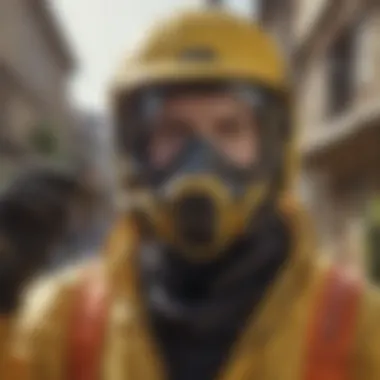

Removing a wasp nest is not just about eliminating an unwanted object from your property. Understanding the risks associated with wasp nests is crucial for ensuring safety and preventing complications. This aspect of wasp removal involves two main categories: health hazards and potential property damage. Addressing these risks can lead to more effective strategies for handling a wasp nest and can help homeowners protect themselves and their homes.
Health Hazards
Allergic Reactions
Allergic reactions to wasp stings can be severe and life-threatening. Many people may not know they are allergic until they are stung for the first time. The body's immune response can trigger a sudden allergic reaction, leading to symptoms such as swelling, difficulty breathing, or even anaphylaxis. This makes the topic of allergic reactions extremely significant when discussing wasp nest removal.
A vital characteristic of allergic reactions is that they can vary greatly from person to person. This variability makes it essential for individuals, especially those with a known allergy history, to approach wasp nests with caution. Homeowners should carefully assess the risks involved in removing the nest. Being informed about allergic reactions can lead to safer removal procedures and avoiding unnecessary exposure during the process.
Additionally, wasps can sting multiple times, increasing the risk of a severe reaction. For someone allergic to wasp venom, a single sting can become a serious matter, making it critical to take preventive measures before engaging in removal strategies.
Multiple Stings
Multiple stings present another significant health hazard linked to wasp nests. Wasps are defensive creatures, and when provoked, they may sting repeatedly. The more stings a person receives, the more venom enters their system, amplifying the risk of severe pain and systemic reactions. This factor can drastically affect the removal strategy, making it important for homeowners to recognize their limitations and seek professional help when necessary.
The key characteristic here is the cumulative effect of venom. Each sting can exacerbate symptoms and increase risk for individuals, especially those with prior reactions. Understanding this can assist in planning a removal process that minimizes the likelihood of provoking the wasps.
Property Damage
Structural Weakening
Wasp nests can cause structural damage to homes, especially if they are built in areas that compromise the integrity of the building. Over time, nests can weaken walls, creating cracks and potentially inviting further infestations from other pests. Highlighting structural weakening helps homeowners realize the importance of addressing wasp nests promptly.
The process of nest removal can prevent further damage to the home. In addition to this, understanding how wasps can harm property is crucial for developing maintenance strategies. Once a nest is identified, taking quick action can protect the property and maintain its value.
One unique feature of this damage is that it may not be visible until significant harm has been done. Early recognition of wasp nests can prevent costly repairs later, motivating homeowners to be proactive rather than reactive.
Re-Infestation Risks
Re-infestation risks pose another concern after nest removal. If not conducted properly, the area may still attract wasps, leading to a cycle of infestation that can become costly and frustrating. This risk is particularly significant when infested areas remain untreated and accessible. For this reason, focusing on re-infestation risks is key in ensuring long-term solutions to wasp problems.
The characteristic of re-infestation is tied to several factors, such as environmental conditions and existing structures in the vicinity. Recognizing these elements allows for more effective control strategies. Homeowners must seal areas where nests were previously located and monitor for renewed activity to ensure that the pests do not return.
In summary, understanding the risks associated with wasp nests is essential for safe and effective removal. The potential health hazards, particularly allergic reactions and the effects of multiple stings, must be addressed. Furthermore, recognizing the risks of structural weakening and re-infestation offers homeowners a better approach to managing wasp-related issues.
Preparing for Removal
Preparation is crucial in the effective removal of a wasp nest. The risks involved can be significant for those unprepared. Taking the time to prepare adequately can reduce the chances of incidents and ensure a smoother process. Proper preparation includes acquiring the necessary safety gear and tools, as well as understanding the behavior of wasps and the appropriate timing for the removal.
Safety Gear Requirements
Before attempting to remove a wasp nest, equipping oneself with the necessary safety gear is essential. This not only protects you from potential stings but also makes the process more manageable and confident.
Protective Clothing
Wearing protective clothing is essential in ensuring safety. The fabric should be thick and durable to prevent stings from penetrating. A key characteristic of protective clothing is its coverage; it should cover as much skin as possible. This characteristic is advantageous because it minimizes exposed areas, reducing the risk of getting stung. Additionally, special suits designed for wasp removal often include integrated hood systems that protect the head and neck. The disadvantage, however, is that such suits may limit mobility.
Face Shield
Using a face shield provides another layer of protection. The face is particularly vulnerable during removal attempts, and ensuring it is shielded can prevent painful stings. A notable feature of a face shield is its ability to offer visibility while ensuring safety. This is especially important because clear sight is necessary when working around a wasp nest. However, ventilation can sometimes be an issue, leading to fogging during removal tasks.
Gloves
Gloves are a must-have for anyone attempting to remove wasp nests. They protect the hands from stings and provide grip when handling tools. A major advantage of gloves is that they come in various materials, including rubber and latex, ensuring flexibility and durability. They should be long enough to cover the wrists. Some gloves are even designed with additional padding for extra protection. However, thick gloves can reduce tactile sensitivity, making it more challenging to perform intricate tasks.
Necessary Tools
Having the right tools makes removal more efficient and safer. Here are the essential tools to consider:
Sprays and Insecticides
Chemical sprays and insecticides are effective in controlling wasps during removal. Their key characteristic is quick action; they can immobilize wasps almost instantly. This is beneficial in reducing immediate threats as you work to remove the nest. A unique feature of these products is the range; some can be used from distances of up to 20 feet, allowing for safer application. However, there are environmental concerns associated with chemical residues.
Smoke Tools
Using smoke tools is a traditional method to subdue wasp activity. Smoke acts as a natural irritant, guiding them away from the nest during removal. A key characteristic of smoke tools is their ability to create a calming effect on wasps, allowing for safer engagement. The advantage of this method is its eco-friendliness compared to chemical options. On the downside, some users may find it requires practice to effectively manage smoke direction.
Nesting Cages
Nesting cages can be beneficial in safely containing wasps during removal. They allow for humane extraction, especially in cases where the complete eradication isn't an option. The notable feature of nesting cages is their lightweight design, making them easy to handle and set up. They provide a secure way to ensure that wasps are relocated rather than killed. However, they do require initial knowledge to set up properly, which some may find challenging.
Preparedness before removing a wasp nest enhances safety and lowers the likelihood of getting stung.
Timing the Removal Process
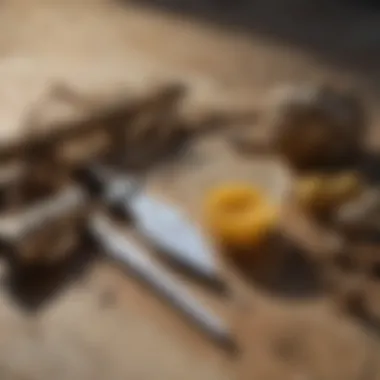

Effective timing is crucial when seeking to remove a wasp nest. The correct timing can significantly minimize risks and enhance the success rate of the removal. Understanding when to approach the nest can ensure that the wasps are less active, making the entire process safer for the individual conducting the removal.
Optimal Times of Day
Dusk and Dawn Considerations
Dusk and dawn are often regarded as the best times to remove a wasp nest. During these periods, wasps tend to be less active. The drop in temperature prompts wasps to become more sluggish, reducing the likelihood that they will aggressively defend their nest.
This is a beneficial choice since it minimizes the chances of stings, making the process safer for homeowners. Additionally, at dusk, many wasps return to their nests for the night, allowing for a more straightforward encounter.
However, one must note that approaching the nest in low light can present its own challenges. Visibility is reduced, which may make it difficult to accurately assess the situation. Homeowners should take care to ensure they have sufficient light to discern the nest and surrounding area while still working within these optimal times.
Weather Conditions
Weather conditions also play a vital role in the timing of wasp nest removal. Ideally, the best weather is calm and dry. Windy and rainy conditions can agitate wasps, prompting them to become more defensive. Hence, a calm day is highly recommended.
Moreover, going out during dry weather helps in observing the wasps’ activity more clearly. A clear understanding of their movements can minimize unexpected encounters while approaching the nest. Weather conditions can change quickly, so monitoring forecasts can be beneficial. In cases where storms are anticipated, postponing the removal process is prudent as wet conditions can also lead to an increased presence of wasps if the nest gets disturbed.
This careful consideration of weather ensures that the removal process is conducted under the safest circumstances, improving overall execution and chances of success.
Seasonal Factors
Spring and Summer Activity
Spring and summer are peak seasons for wasp activity. During these months, wasps are building their nests and foraging for food. The increased wasp population means the risk of confrontations is higher during these times.
Understanding this seasonal activity helps homeowners plan their approach effectively. It may be wise to look for nests early in spring before they expand or become filled with many wasps. Prompt action during this period can prevent more significant problems later in the summer when nests are at their largest and most active.
However, removing a nest during spring can be tricky, as wasps are still establishing their territory. The aggressiveness can vary, depending on the species involved at the time.
Late Season Risks
Late in the season, the dynamics of wasp behavior shift again. By this time, nests reach their maximum size and can contain hundreds of wasps. At this point, aggressive behavior tends to increase as wasps protect their territory more fiercely.
Additionally, behavior can become erratic as the season comes to an end. A late season removal can be dangerous, with risks of multiple stings if disturbed. Therefore, the timing for removal needs careful planning and consideration.
Homeowners may consider waiting until late autumn when most wasps have died off or are too inactive, making removal safer but potentially leaving nests present for a longer period.
Methods for Safe Removal
Removing a wasp nest requires careful consideration and proper methods to ensure safety. The approach taken can influence not only the success of the removal but also minimize risks to the individual performing the task. Therefore, these methods can prioritize personal safety and lower the chance of agitating the wasps, which is critical for effective pest management.
Chemical Approaches
Targeted Insecticides
Targeted insecticides are a popular choice for wasp nest removal, mainly due to their effectiveness. These products are designed to kill specific insects and are generally more focused than broad-spectrum insecticides. A key characteristic of targeted insecticides is their ability to affect only the intended pests while posing less risk to beneficial insects. This specificity makes them a beneficial option when aiming for quick elimination of the wasps.
However, it is essential to apply these insecticides carefully. One unique feature of targeted insecticides is their delayed action. This allows wasps to carry the poison back to the nest, affecting others, which can be advantageous for complete nest eradication. Despite their effectiveness, there can be disadvantages, such as potential toxicity to humans and pets, if not handled properly. Use caution while applying; protective gear is always recommended.
Foam Sprays
Foam sprays are another effective chemical approach to removing wasp nests. The foam expands on contact, filling cracks and crevices where wasps might be hiding. This helps to ensure better coverage and can reduce the likelihood of wasps escaping the treatment. A notable characteristic of foam sprays is their ease of application; homeowners can often reach nests that might otherwise be difficult to spray.
The unique feature of foam sprays often revolves around their residue. While they effectively kill wasps on contact, the foam helps deter future infestations. Although these sprays can be effective, the disadvantage is that they might require multiple applications for larger nests, which can be time-consuming. Moreover, using foam in windy conditions can lead to drift, affecting areas not intended for treatment.
Non-Chemical Approaches
Vacuum Removal
Vacuum removal is a non-chemical method that can be effective for nests in specific locations. This approach utilizes a powerful vacuum to physically remove the wasps from the nest and is especially suitable for smaller nests. A key characteristic of vacuum removal is that it provides immediate removal without releasing insecticides into the environment, making it a safer option for those living near children or pets.
One unique feature of vacuum removal is that it can often be done while wearing protective gear. The vacuum hose can be placed close to the nest, allowing for a safe distance from any potentially aggressive wasps. However, a disadvantage is that this method may not work effectively on larger nests or in situations where wasps are particularly aggressive. Thus, it requires a good assessment of the situation before choosing this method.
Smoke Disruption
Smoke disruption is a technique that utilizes smoke to calm wasps, making removal easier. The presence of smoke can confuse and disorient the wasps, causing them to retreat deeper into the nest. A critical characteristic of this method is its reliance on the natural behavior of wasps, which find smoke distressing. This approach can be beneficial as it limits risks of stings during the removal process.
The unique feature of smoke disruption is its use as a preliminary step before applying other methods. This can create a safer working environment. However, there are disadvantages to consider. This method is weather-dependent; high winds can disperse smoke too quickly. Additionally, it might not eliminate all wasps, requiring a follow-up with chemical treatments or other removal strategies.
Wasp Traps
Attracting Wasps
Wasp traps are an innovative tool designed to lure and capture wasps. The effectiveness of these traps lies in their design, which usually involves bait to attract the wasps into a container where they cannot escape. A key characteristic of wasp traps is their simplicity; they can often be homemade or purchased from local stores.
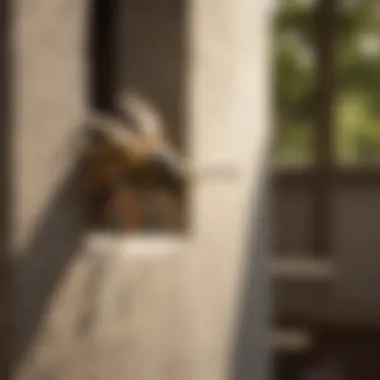
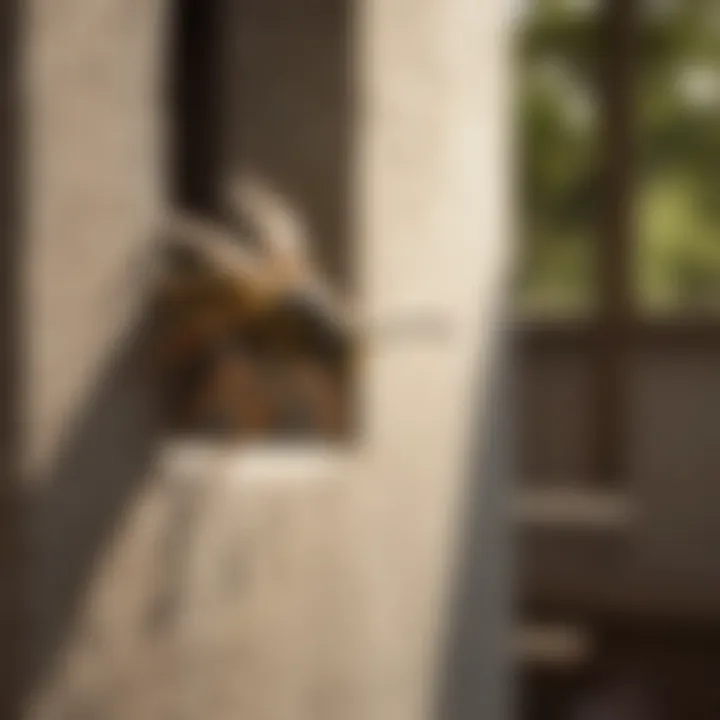
The unique feature of attracting wasps involves the placement of these traps strategically near known hover areas. When the traps work effectively, they reduce the number of wasps around the home before any major removal activities take place, making the removal process easier. However, a disadvantage is that these traps may not lower the wasp population significantly if a nest is nearby, as trapped wasps can be replaced by others.
Trapping Techniques
Trapping techniques focus on the various methods to effectively capture wasps. Common techniques include using pheromone baits or scents that are particularly attractive to wasps. A significant characteristic of trapping techniques is their ability to continuously reduce wasp numbers after initial removal by keeping them away from the vicinity.
The unique feature of this method is its potential for ongoing pest control. Using traps, homeowners can monitor and control wasp populations throughout the season. However, while these traps can be effective, they require regular maintenance and replacement to ensure ongoing effectiveness.
Effective wasp management combines different methods to ensure both the safety of individuals and the effectiveness of the removal process.
Combining these methods can lead to a holistic plan for safe removal and reduction of wasp nests around the home.
Post-Removal Actions
Post-removal actions are critical for ensuring that the removal process of a wasp nest is not only effective but also sustainable. The focus shifts from immediate removal to long-term management. Once a nest is removed, it is important to thoroughly clean the area to eliminate any remnants that may attract new wasps or other pests. Additionally, taking preventive measures helps to protect your home from future infestations, making these actions essential for practical pest management.
Cleaning the Area
Removing Nest Remnants
Removing nest remnants is an important task after the actual removal of the wasp nest. Careful removal can significantly reduce the chance of attracting other wasps. Wasps can become competitive about territory, thus, any scent or detritus left behind from the original nest acts as a beacon. Therefore, homeowners are encouraged to take this action seriously.
A key characteristic of removing nest remnants is the need for thoroughness. Assessing the area for any leftover materials that might retain pheromones, which are chemical signals, is essential. This step is a beneficial choice as it contributes to the overall clean-up strategy, ensuring there is no additional attraction for new wasps. The unique feature lies in observing the attention to detail in this process.
However, it is important to note that hasty removal might not account for all hidden remnants, potentially leading to re-infestation. Therefore, utilizing gloves or other protective gear during the removal process is crucial to avoid any residual stings from any remaining angry wasps.
Disinfecting Surfaces
Disinfecting surfaces after nest removal is equally as important. The act of disinfecting helps to eliminate any bacteria or pathogens that could linger after the nest is gone. This process contributes to the goal of cleanliness and safety in the environment, making it a necessary step.
A key characteristic of disinfecting surfaces is its role in enhancing safety. The choice to disinfect is highly beneficial as it ensures that the area does not pose health risks to humans or pets. The unique feature of this action is its ability to provide a fresh start in the previously infested space.
Using common disinfectants poses some advantages like ease of access and effectiveness against a range of bacteria. However, caution must be exercised with the chemicals used, ensuring they are safe for home use and do not pose other risks.
Preventing Future Infestations
Preventing future infestations is as important as the removal of wasp nests. This process entails actionable steps to ensure that wasps do not return to your home after removal. Addressing these aspects thoroughly sets a basis for sustained pest control.
Regular Inspections
Conducting regular inspections of the property is one of the most effective prevention strategies. Through inspections, homeowners can identify any new nest formations early. Regular inspections are beneficial as they provide an ongoing assessment of the home, allowing for prompt action if a nest is discovered.
A key characteristic of this approach is its preventative nature. Investing time in regular inspections prevents larger issues, making it a favored choice for many homeowners. The unique feature of regular inspections is the proactive stance it takes against potential infestations, rather than reactive measures.
However, it requires diligence and commitment to check vulnerable areas consistently, avoiding complacency after an initial removal.
Sealing Entry Points
Sealing entry points is another critical action for preventing future infestations. This involves identifying and sealing any gaps, cracks or crevices that could offer wasps easy access to your home. Taking this step contributes directly to the goal of avoidance.
A key characteristic of sealing entry points is its holistic approach. By sealing potential entry points, you diminish the likelihood that any wasps will get indoors. This method becomes a beneficial choice because it not only prevents wasps but also enhances energy efficiency of the home by reducing drafts.
The unique feature of this process lies in the long-term security it provides. However, it can be labor-intensive, as it might require close examination of the building's exterior and potential ongoing maintenance work when weathering shows wear.
"Taking post-removal actions is essential for long-term pest control and maintaining a safe home environment."
Ecological Considerations
Understanding ecological considerations when dealing with wasp nests is crucial. Wasps play essential roles in various ecosystems. They are not only a part of the food web, but they also contribute in ways that impact agriculture and natural environments.
The Role of Wasps in Ecosystems
Pollination
Pollination is a vital service that wasps provide. Many wasps feed on nectar, which leads them to flowers. As they move from one flower to another, they transfer pollen. This process is essential for plant reproduction. Wasps assist in pollinating certain plants, enhancing biodiversity. This helps maintain healthy ecosystems. If we ignore this aspect, we risk disrupting the balance in nature. Thus, recognizing this role is important when considering wasp removal strategies.
Pest Control
Another significant function of wasps is pest control. Wasps are predators that feed on various insects, including pests that harm crops. They help naturally regulate pest populations. This makes them a beneficial ally in maintaining healthy gardens and farms. By controlling pest populations, wasps reduce the need for chemical insecticides. This aspect is often overlooked in discussions about wasp removal. Understanding this role underlines the need for responsible pest management practices.
Responsible Removal Practices
As we consider removal options, responsible practices should govern our decisions. It is vital to weigh the ecological impact of our actions.
Humane Alternatives
Humane alternatives in wasp removal encourage coexistence rather than extermination. This option focuses on relocating wasps instead of killing them. Techniques such as using traps that catch wasps without harming them can be effective. Many homeowners prefer humane methods as they preserve the ecological benefits wasps provide. By using humane alternatives, we can avoid the negative impact on the ecosystem, contributing to a more balanced approach to pest management.
Consulting Professionals
Consulting professionals for wasp removal is often a wise choice. Experts have the knowledge and tools needed to handle wasp nests safely. They can assess the situation, ensuring ecological considerations are taken into account. Professional services can often suggest solutions that minimize harm to both the wasps and the environment. This strategy may come at a cost, but it can prevent the potential dangers of amateur removal efforts. Using professionals is beneficial because it combines safety with an understanding of ecological impact.



